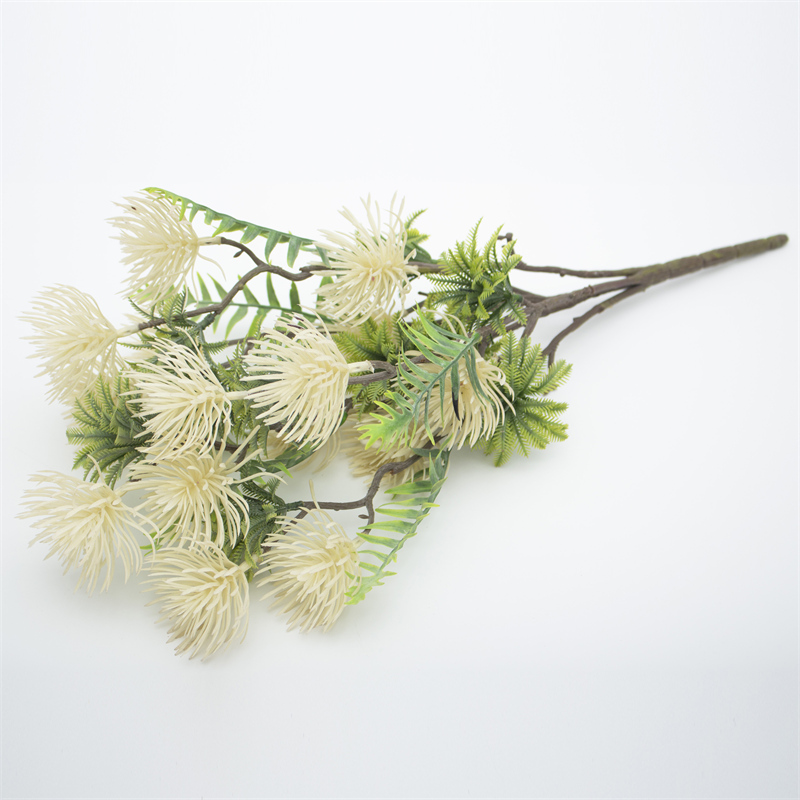
Artificial Flowers are the perfect fusion of artistry and material science. They are created to replicate the beauty of natural flora while offering durability, versatility, and timeless decorative value. With advanced manufacturing and high-quality materials, our products provide lifelike texture, long-lasting color, and sustainable usability.

artificial flowers are crafted imitations of real plants, designed through precise modeling, manual shaping, and layered coloring. Their purpose is not only to mimic the visual beauty of real flowers but also to extend it — making floral aesthetics available anywhere, regardless of season or environment.
Unlike natural blooms, artificial flowers:
Retain their form and vibrancy for years without watering or sunlight.
Are allergy-free, suitable for indoor environments.
Can be customized in size, color, and composition to meet various design needs.
Modern artificial flowers combine premium fabrics, PU and EVA polymers, and handcrafting techniques, resulting in decorations that look organic yet maintain industrial precision.
The choice of materials defines the quality, realism, and tactile experience of artificial flowers. Below is a comparison of the main materials used in our production.
| Material | Features | Advantages | Ideal Use |
|---|---|---|---|
| Silk Fabric (High-grade Polyester) | Smooth and lightweight, with fine weaving that mimics silk | Soft luster, easy shaping, realistic color layering | Petals, leaves, small blossoms |
| PU (Polyurethane) | Soft-touch, elastic surface similar to real petals | Feels lifelike, maintains flexibility and form | Rose petals, succulents, thick leaves |
| Latex Blends | Thin, flexible layers for natural petal curves | Highly realistic, moisture-resistant | Orchids, tulips, tropical flowers |
| PE / EVA Plastics | Soft yet durable polymer compounds | Moldable, UV-stable, colorfast | Structural stems, berries, fruits |
| Natural Elements | Dried stems, vine rings, rattan bases | Eco-friendly, organic appearance | Wreaths, seasonal decor bases |
Our products primarily use PU and silk-blend fabrics, ensuring both visual delicacy and durability. Each petal and leaf is carefully processed for matte finish, realistic translucence, and authentic movement when arranged.
The artistry of artificial flowers lies in the refined multi-step production process, where precision and craftsmanship converge.
Production process:
embryo bottom polishing → surface processing → manual coloring → assembly of accessories → packaging in boxes
Embryo Bottom Polishing – The core frame of each petal is cut, shaped, and smoothed to eliminate edges, preparing the surface for treatment.
Surface Processing – Textures and veins are embossed using heated molds, giving the flower realistic detailing.
Manual Coloring – Skilled artisans apply layered pigments by airbrush or hand to achieve gradient color transitions, matching natural hues.
Accessory Assembly – Leaves, stems, and floral bases are assembled around flexible wire cores, ensuring strong yet adjustable structures.
Packaging in Boxes – Finished pieces are arranged, inspected, and securely boxed to maintain form during shipment.
This combination of mechanical precision and handcrafting expertise guarantees the natural realism and consistent quality of every product.
To achieve high-grade texture and color consistency, we employ advanced semi-automatic and precision machinery during manufacturing.
Production equipment:
VNet 60 roller polishing machine, semi-automatic coloring agent mixer, semi-automatic inserting plate rotating machine, high-temperature independent baking room.
VNet 60 Roller Polishing Machine: Delivers fine surface polishing for smooth, uniform textures.
Semi-Automatic Coloring Agent Mixer: Ensures stable pigment blending for consistent hue and brightness.
Inserting Plate Rotating Machine: Enhances assembly efficiency and precision during petal-stem integration.
High-Temperature Baking Room: Fixes color layers, improving durability and resistance to fading or cracking.
This production setup balances mechanical uniformity and manual artistry, ensuring every batch maintains the same natural appearance and tactile feel.
Artificial flowers produced with our materials and processes are suitable for a wide range of applications:
Used for living rooms, offices, hotels, and restaurants to bring long-lasting natural charm without maintenance. Their color stability and realistic look maintain freshness in any environment.
Ideal for brand displays, window decoration, and themed events. Artificial flowers convey elegance, reliability, and consistent visual branding across seasons.
Preferred by event planners for large installations such as floral arches, centerpieces, and photo walls due to their flexibility, light weight, and reusability.
Customized wreaths, garlands, and arrangements for Christmas, Easter, and autumn festivals — maintaining vibrancy throughout repeated usage cycles.
Can be used in handmade projects, packaging, or fashion accessories — offering artisans creative possibilities without time limits imposed by fresh materials.
While artificial flowers require little upkeep, proper maintenance extends their lifespan and preserves their aesthetic quality.
Dust Removal: Use a soft brush, blower, or dry microfiber cloth to remove accumulated dust from petals and leaves.
Color Protection: Keep arrangements away from direct sunlight to prevent UV fading.
Shape Retention: Gently reshape stems and petals if compressed during storage.
Cleaning: For PU or plastic components, lightly wipe with damp cloth; avoid harsh detergents.
Storage: Store in ventilated, dry spaces; avoid sealed plastic bags that trap moisture.
These care steps ensure that each arrangement remains vivid and graceful, retaining both structural and visual integrity over time.
Artificial flowers are a harmonious blend of modern material innovation and artisanal craftsmanship. Through advanced fabrics, eco-friendly polymers, and meticulous hand-finishing, they offer an enduring expression of nature’s beauty.
From realistic texture to sustainable design, they bridge the gap between artistry and functionality — making floral aesthetics accessible in any space or season.